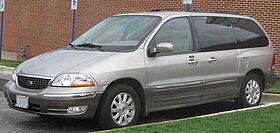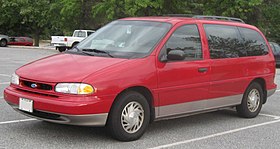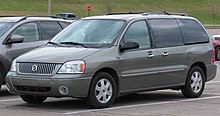
Minivan is a car classification for vehicles designed to transport passengers in the rear seating row(s), with reconfigurable seats in two or three rows. The equivalent classification in Europe is MPV or M-segment.

The Mazda MPV is a minivan manufactured by Mazda. Introduced in 1988 as a rear-wheel-drive model with optional selectable four-wheel drive, this was replaced in 1999 with a front-wheel-drive version with optional all-wheel-drive in some markets. Over one million MPV models have been produced since its introduction.

The Chrysler minivans are a series of minivans that have been produced and marketed by the American automaker Chrysler since the 1984 model year. Currently in its sixth generation, the model line is marketed worldwide, primarily in North America and Europe. Introduced as the Dodge Caravan and Plymouth Voyager, the Chrysler minivans have been marketed under a variety of nameplates under the Chrysler, Plymouth, Dodge, and Ram brands; through the use of rebadging, the model line has also been marketed under the Lancia and Volkswagen brands.

Plymouth Voyager is a nameplate for a range of vans that were marketed by the Plymouth division of Chrysler. From 1974 until 1983, the Voyager was a full-size van, sold as the counterpart of Dodge Sportsman. Starting with the 1984 model year, the Voyager was marketed as one of the new Chrysler minivan, along with the Dodge Caravan. As a minivan, there were three generations of the Voyager from 1984 until 2000. Following the closure of the Plymouth division in 2000, the Voyager was marketed under the Chrysler brand as a lower-trim version of the Chrysler Town & Country through 2003.

The Mercury Villager is a minivan that was marketed by Mercury from 1993 to 2002. Taking its name used by Mercury to denote its wood-trimmed station wagons, the Villager was developed in a joint venture between Ford and Nissan; the latter manufacturer marketed the line as the Nissan Quest. The first front-wheel drive van produced by Ford, the Mercury Villager was introduced between the Ford Aerostar and the Ford Windstar, competing against Chrysler minivans and the General Motors APV minivans.
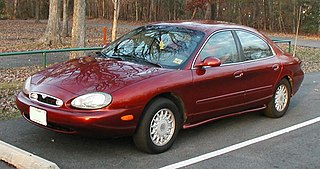
The Mercury Sable is a range of automobiles manufactured and marketed by the Mercury brand of Ford Motor Company. Introduced on December 26, 1985, as the replacement for the Mercury Marquis, the Sable marked the transition of the mid-size Mercury product range to front-wheel drive.

The Chrysler Town & Country is a minivan that was manufactured and marketed by Chrysler from 1990 to the 2016 model years. The third Chrysler minivan introduced in North America, the Town & Country adopted its nameplate from the flagship Chrysler station wagon line, adopting its exterior woodgrain trim as a design feature for several generations.
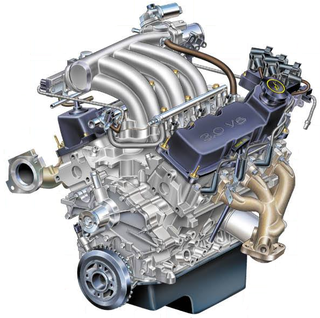
The Ford Vulcan is a 3.0 L V6 engine designed and built by the Ford Motor Company. It debuted in 1986 in the newly launched Ford Taurus. Ford went on to install the Vulcan V6 in a variety of car, van, and pickup truck models until the 2008 model year, after which production stopped.

The Ford Aerostar is a range of vans that was manufactured by Ford from the 1986 to the 1997 model years. The first minivan produced by Ford, the model line was marketed against the Chevrolet Astro/GMC Safari and the first two generations of the Chrysler minivans. Introduced shortly before the Ford Taurus, the Aerostar derived its name from its slope-nosed "one-box" exterior.

The Chevrolet Lumina APV is a minivan that was produced by the Chevrolet division of General Motors. The first front-wheel drive minivan sold by Chevrolet, the Lumina APV was sold in a single generation from the 1990 to 1996 model years. Marketed alongside the Pontiac Trans Sport and Oldsmobile Silhouette, the Lumina APV competed against the Dodge Grand Caravan/Plymouth Grand Voyager, the extended-length Ford Aerostar, and the Mazda MPV.

The Ford Tempo is an automobile that was produced by Ford from the 1984 to 1994 model years. The successor of the Ford Fairmont, the Tempo marked both the downsizing of the Ford compact car line and its adoption of front-wheel drive. Through its production, the model line was offered as a two-door coupe and four-door sedan, with the Mercury Topaz marketed as its divisional counterpart.

The Nissan Quest is a minivan manufactured and marketed by Nissan for model years 1993–2017 over four generations.

The Ford Freestyle is a crossover utility vehicle that was sold by Ford from 2005 to 2009. Largely marketed as the successor to the Ford Taurus station wagon, the Freestyle was the CUV counterpart of the Ford Five Hundred and Mercury Montego four-door sedans. Sharing the Ford D3 platform with the Five Hundred and Montego, the Freestyle was produced with both front-wheel drive and all-wheel drive configurations and six- or seven-passenger seating.
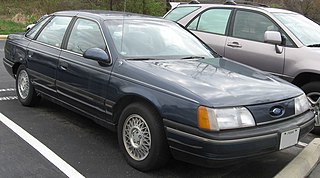
The first-generation Ford Taurus and Mercury Sable are automobiles produced by Ford as the first of six generations of the Ford Taurus and Mercury Sable. Launched on December 26, 1985, as a 1986 model, the front-wheel-drive Taurus was a very influential design that is credited with saving Ford from bankruptcy, bringing many innovations to the marketplace and starting the trend towards aerodynamic design for the American automakers in the North American market. Ford of Europe had launched the 1980s move to aerodynamic design for the company with the 1982 Ford Sierra.

The second-generation Ford Taurus is an automobile that was produced by Ford from 1991 to 1995, which served as the second out of six generations of the Ford Taurus. The second-generation Taurus shared all of its mechanical parts with the first-generation Ford Taurus, yet its exterior and interior were nearly completely redesigned. However, its exterior still strongly resembled that of the first-generation Taurus, leading many to believe that the second-generation was simply a facelift of the first-generation Taurus. However, this is partially true because the wagon model, from the B-pillar to the rear of the car, was a carryover from the first generation. The second generation of Taurus proved to be very popular, selling 410,000 units in its first year, becoming the best-selling car in the United States. It would hold this title until 1995, when it was discontinued and replaced with the third-generation Ford Taurus.
The Ford Carousel is a prototype vehicle that was developed by Ford in 1973. A derivative of the third-generation Ford Econoline/Club Wagon, the Carousel explored a number of the concepts that 1980s American-market minivans later put into production, serving as an alternative to both full-size station wagons and passenger vans.

The Ford Mondeo I (first generation) is a mid-size car that was produced by Ford, beginning on 23 November 1992, with sales beginning on 22 March 1993. It is also known as the Mk I Mondeo; the 1996 facelift versions are usually designated Mk II. Available as a four-door saloon, a five-door hatchback, and a five-door estate, all models for the European market were produced at Ford's plant in the Belgian city of Genk. In December 1992, Autocar published a section on the Mondeo, and how it would conquer rivals.

The first-generation Chrysler minivans are a series of minivans produced and marketed by the Chrysler Corporation from the 1984 to the 1990 model years. Introduced as the first minivans from an American-brand manufacturer and popularizing the minivan as a vehicle, the Dodge Caravan and Plymouth Voyager were launched ahead of chief competitors Chevrolet Astro/GMC Safari and Ford Aerostar.
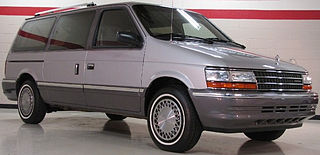
The second-generation Chrysler minivans are a series of minivans that were manufactured and marketed by Chrysler Corporation in North America and Europe from 1991 to 1995. Officially designated the AS platform by Chrysler, the second-generation minivans were an extensive revision of the first-generation chassis and body. As before, passenger and cargo configurations were sold by Dodge, Plymouth, and Chrysler divisions. The first minivans offered with driver-side airbags and with optional integrated child safety seats, the second-generation Chrysler minivans offered all-wheel drive as an option for the first time; a manual transmission would be offered for the last time in the North American market.

The third-generation Chrysler minivans are a series of passenger minivans that were marketed by the Chrysler Corporation from the 1996 to 2000 model years. The first ground-up redesign of the model lines since their introduction, designers added a further degree of divisional identity between the Plymouth Voyager, Dodge Caravan, and Chrysler Town & Country. In a notable change, the cargo van was discontinued, with all examples sold as passenger vans. Coinciding with the retirement of the Plymouth brand during 2001, this is the final generation marketed as the Plymouth Voyager.
